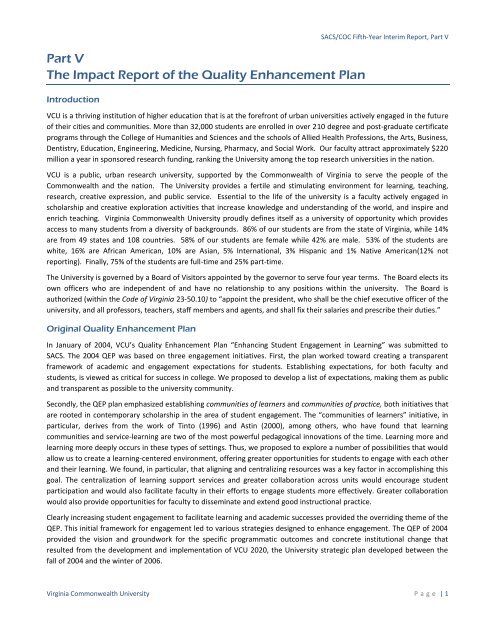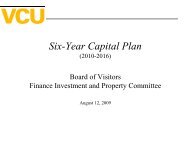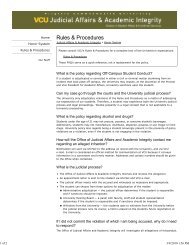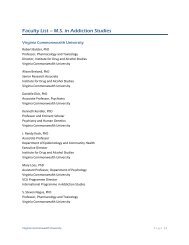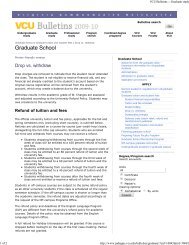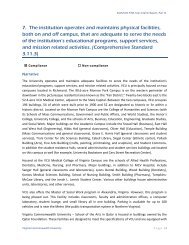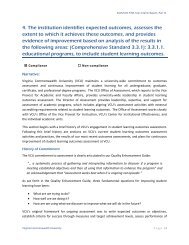Part V of the Fifth-Year Interim Report - VCU SACS/COC Tenth Year ...
Part V of the Fifth-Year Interim Report - VCU SACS/COC Tenth Year ...
Part V of the Fifth-Year Interim Report - VCU SACS/COC Tenth Year ...
Create successful ePaper yourself
Turn your PDF publications into a flip-book with our unique Google optimized e-Paper software.
<strong>Part</strong> V<br />
The Impact <strong>Report</strong> <strong>of</strong> <strong>the</strong> Quality Enhancement Plan<br />
Introduction<br />
<strong>SACS</strong>/<strong>COC</strong> <strong>Fifth</strong>-<strong>Year</strong> <strong>Interim</strong> <strong>Report</strong>, <strong>Part</strong> V<br />
<strong>VCU</strong> is a thriving institution <strong>of</strong> higher education that is at <strong>the</strong> forefront <strong>of</strong> urban universities actively engaged in <strong>the</strong> future<br />
<strong>of</strong> <strong>the</strong>ir cities and communities. More than 32,000 students are enrolled in over 210 degree and post-graduate certificate<br />
programs through <strong>the</strong> College <strong>of</strong> Humanities and Sciences and <strong>the</strong> schools <strong>of</strong> Allied Health Pr<strong>of</strong>essions, <strong>the</strong> Arts, Business,<br />
Dentistry, Education, Engineering, Medicine, Nursing, Pharmacy, and Social Work. Our faculty attract approximately $220<br />
million a year in sponsored research funding, ranking <strong>the</strong> University among <strong>the</strong> top research universities in <strong>the</strong> nation.<br />
<strong>VCU</strong> is a public, urban research university, supported by <strong>the</strong> Commonwealth <strong>of</strong> Virginia to serve <strong>the</strong> people <strong>of</strong> <strong>the</strong><br />
Commonwealth and <strong>the</strong> nation. The University provides a fertile and stimulating environment for learning, teaching,<br />
research, creative expression, and public service. Essential to <strong>the</strong> life <strong>of</strong> <strong>the</strong> university is a faculty actively engaged in<br />
scholarship and creative exploration activities that increase knowledge and understanding <strong>of</strong> <strong>the</strong> world, and inspire and<br />
enrich teaching. Virginia Commonwealth University proudly defines itself as a university <strong>of</strong> opportunity which provides<br />
access to many students from a diversity <strong>of</strong> backgrounds. 86% <strong>of</strong> our students are from <strong>the</strong> state <strong>of</strong> Virginia, while 14%<br />
are from 49 states and 108 countries. 58% <strong>of</strong> our students are female while 42% are male. 53% <strong>of</strong> <strong>the</strong> students are<br />
white, 16% are African American, 10% are Asian, 5% International, 3% Hispanic and 1% Native American(12% not<br />
reporting). Finally, 75% <strong>of</strong> <strong>the</strong> students are full-time and 25% part-time.<br />
The University is governed by a Board <strong>of</strong> Visitors appointed by <strong>the</strong> governor to serve four year terms. The Board elects its<br />
own <strong>of</strong>ficers who are independent <strong>of</strong> and have no relationship to any positions within <strong>the</strong> university. The Board is<br />
authorized (within <strong>the</strong> Code <strong>of</strong> Virginia 23-50.10) to “appoint <strong>the</strong> president, who shall be <strong>the</strong> chief executive <strong>of</strong>ficer <strong>of</strong> <strong>the</strong><br />
university, and all pr<strong>of</strong>essors, teachers, staff members and agents, and shall fix <strong>the</strong>ir salaries and prescribe <strong>the</strong>ir duties.”<br />
Original Quality Enhancement Plan<br />
In January <strong>of</strong> 2004, <strong>VCU</strong>’s Quality Enhancement Plan “Enhancing Student Engagement in Learning” was submitted to<br />
<strong>SACS</strong>. The 2004 QEP was based on three engagement initiatives. First, <strong>the</strong> plan worked toward creating a transparent<br />
framework <strong>of</strong> academic and engagement expectations for students. Establishing expectations, for both faculty and<br />
students, is viewed as critical for success in college. We proposed to develop a list <strong>of</strong> expectations, making <strong>the</strong>m as public<br />
and transparent as possible to <strong>the</strong> university community.<br />
Secondly, <strong>the</strong> QEP plan emphasized establishing communities <strong>of</strong> learners and communities <strong>of</strong> practice, both initiatives that<br />
are rooted in contemporary scholarship in <strong>the</strong> area <strong>of</strong> student engagement. The “communities <strong>of</strong> learners” initiative, in<br />
particular, derives from <strong>the</strong> work <strong>of</strong> Tinto (1996) and Astin (2000), among o<strong>the</strong>rs, who have found that learning<br />
communities and service-learning are two <strong>of</strong> <strong>the</strong> most powerful pedagogical innovations <strong>of</strong> <strong>the</strong> time. Learning more and<br />
learning more deeply occurs in <strong>the</strong>se types <strong>of</strong> settings. Thus, we proposed to explore a number <strong>of</strong> possibilities that would<br />
allow us to create a learning-centered environment, <strong>of</strong>fering greater opportunities for students to engage with each o<strong>the</strong>r<br />
and <strong>the</strong>ir learning. We found, in particular, that aligning and centralizing resources was a key factor in accomplishing this<br />
goal. The centralization <strong>of</strong> learning support services and greater collaboration across units would encourage student<br />
participation and would also facilitate faculty in <strong>the</strong>ir efforts to engage students more effectively. Greater collaboration<br />
would also provide opportunities for faculty to disseminate and extend good instructional practice.<br />
Clearly increasing student engagement to facilitate learning and academic successes provided <strong>the</strong> overriding <strong>the</strong>me <strong>of</strong> <strong>the</strong><br />
QEP. This initial framework for engagement led to various strategies designed to enhance engagement. The QEP <strong>of</strong> 2004<br />
provided <strong>the</strong> vision and groundwork for <strong>the</strong> specific programmatic outcomes and concrete institutional change that<br />
resulted from <strong>the</strong> development and implementation <strong>of</strong> <strong>VCU</strong> 2020, <strong>the</strong> University strategic plan developed between <strong>the</strong><br />
fall <strong>of</strong> 2004 and <strong>the</strong> winter <strong>of</strong> 2006.<br />
Virginia Commonwealth University P a g e | 1
<strong>SACS</strong>/<strong>COC</strong> <strong>Fifth</strong>-<strong>Year</strong> <strong>Interim</strong> <strong>Report</strong>, <strong>Part</strong> V<br />
Strategic Plan 2020<br />
As soon as <strong>VCU</strong> was reaffirmed by <strong>SACS</strong> in 2004, President Trani determined it was time for a new strategic plan that<br />
would guide <strong>the</strong> university for <strong>the</strong> next fifteen years, hence <strong>the</strong> development <strong>of</strong> <strong>VCU</strong> 2020. The development <strong>of</strong> <strong>the</strong> new<br />
strategic plan was fortuitous, as it presented <strong>the</strong> opportunity to embed much <strong>of</strong> <strong>the</strong> framework <strong>of</strong> <strong>the</strong> 2004 QEP into <strong>the</strong><br />
future plans <strong>of</strong> <strong>the</strong> entire university. While five overarching <strong>the</strong>mes structure <strong>VCU</strong> 2020, Theme II <strong>of</strong> <strong>the</strong> plan addresses<br />
<strong>the</strong> QEP initiatives directly. Theme II is <strong>the</strong> charge “to achieve national recognition as a learning-centered research<br />
university that embraces a world-class student experience.” This <strong>the</strong>me embodied <strong>the</strong> vision <strong>of</strong> <strong>the</strong> student engagement<br />
QEP and, if accomplished, would fully realize <strong>the</strong> plan’s call. The charge <strong>the</strong>n became finding <strong>the</strong> funding to see <strong>the</strong><br />
engagement vision put into action. Concurrent with <strong>the</strong> development <strong>of</strong> <strong>the</strong> <strong>VCU</strong> 2020 plan, <strong>the</strong> state <strong>of</strong> Virginia<br />
distributed money defined as “base adequacy” dollars. These were dollars directed at universities based on <strong>the</strong><br />
relationships between <strong>the</strong>ir state budget and <strong>the</strong>ir current enrollments. As Virginia’s largest state university, <strong>VCU</strong>’s “base<br />
adequacy” allocation was quite generous. This allocation <strong>of</strong> funds provided <strong>the</strong> opportunity to do something on a larger<br />
scale than was originally planned in <strong>the</strong> 2004 QEP.<br />
As a result, <strong>the</strong> Theme II sub-committee <strong>of</strong> <strong>the</strong> <strong>VCU</strong> 2020 investigated initiatives regarding student learning and<br />
experience. With careful analysis <strong>of</strong> <strong>the</strong> QEP combined with research and comparative study <strong>of</strong> best practices across <strong>the</strong><br />
nation, <strong>the</strong> committee determined what <strong>VCU</strong> could do over fifteen years that would increase student engagement and<br />
learning. This resulted in two critical proposals: 1) <strong>the</strong> call for <strong>the</strong> establishment <strong>of</strong> a University College, and 2) a mandate<br />
to develop a core curriculum for <strong>the</strong> entire university.<br />
Strategic Plan: University College<br />
University College (UC) was established to provide a single home for interrelated programs, services, and learning<br />
opportunities for all students, but particularly first-year students. The intent <strong>of</strong> University College was to dramatically<br />
enrich <strong>the</strong> undergraduate experience. Our own data shows that grades earned <strong>the</strong> first semester <strong>of</strong> <strong>the</strong> first college year<br />
are <strong>the</strong> best predictor <strong>of</strong> a student’s overall success toward college graduation. Grades earned during <strong>the</strong> second<br />
semester are <strong>the</strong> next best predictor <strong>of</strong> academic success. Clearly, <strong>the</strong> first-year experience is <strong>the</strong> cornerstone <strong>of</strong> a<br />
student’s college career.<br />
Prior to <strong>the</strong> creation <strong>of</strong> University College, many key support people and much <strong>of</strong> <strong>the</strong> work – learning support, for<br />
example, and first-year student advising – had been spread throughout <strong>the</strong> university in various schools. In contrast, a<br />
single unit would capitalize on <strong>the</strong> power <strong>of</strong> a combined, collaborative resource space and reduce, if not eliminate,<br />
inconsistencies and irregularities across <strong>the</strong> schools in terms <strong>of</strong> advising and learning support. To that end, University<br />
College now houses first year advisors for all programs in one building on a single floor. These advisors form a community<br />
<strong>of</strong> pr<strong>of</strong>essionals who meet on a regular basis and share information throughout each day. Academic Advising <strong>of</strong>fers an<br />
array <strong>of</strong> learning and social support opportunities for students through course <strong>of</strong>ferings and special programs and<br />
workshops. In <strong>the</strong> same first floor space, students will find <strong>the</strong> University Writing Center, <strong>the</strong> University Learning Center<br />
and <strong>the</strong> staff for New Student Programs. New students are encouraged to view University College as <strong>the</strong> place to come<br />
with any questions or problems <strong>the</strong>y may have during <strong>the</strong> year. It is also a central space for student engagement, <strong>of</strong>fering<br />
daily opportunities for learning and collaboration in informal and more formal ways. For example, <strong>the</strong> University College<br />
<strong>of</strong>fers group study space, ongoing tutoring and supplemental instruction, and opportunities for students to receive oneon-one<br />
consultation services for writing, as well as skills and concept-based workshops. The University College also<br />
provides leadership and employment opportunities for <strong>VCU</strong>’s highest performing students, who work as peer mentors,<br />
tutors, and writing consultants.<br />
The sections which follow detail <strong>the</strong> primary objectives <strong>of</strong> <strong>the</strong> University College and its progress to date.<br />
Creating <strong>the</strong> Core Curriculum<br />
The proposal to establish a Core Curriculum formed <strong>the</strong> second major initiative resulting from <strong>VCU</strong> 2020. Along with <strong>the</strong><br />
Core emerged a pledge to create <strong>the</strong> <strong>VCU</strong> Compact. The Compact commits <strong>the</strong> University to creating a shared experience<br />
for all undergraduates, an experience which focuses on <strong>the</strong> foundations necessary to enable and ensure lifelong learning.<br />
Virginia Commonwealth University P a g e | 2
<strong>SACS</strong>/<strong>COC</strong> <strong>Fifth</strong>-<strong>Year</strong> <strong>Interim</strong> <strong>Report</strong>, <strong>Part</strong> V<br />
In <strong>the</strong> ensuing three years, after discussion, input, and debate by faculty throughout <strong>the</strong> University community, <strong>the</strong> Core<br />
Curriculum was integrated into all programs as <strong>of</strong> fall 2009.<br />
As with <strong>the</strong> University College, student engagement is a fundamental principle <strong>of</strong> <strong>the</strong> new Core Curriculum. The Core is<br />
based on a learning-centered approach to both teaching and learning, an approach that aims to encourage shared<br />
experience. Integration and cohesion are central goals <strong>of</strong> <strong>the</strong> new core curriculum. The Core is fundamentally<br />
transformative: it seeks to reenergize <strong>the</strong> traditional general education model <strong>of</strong> discrete and <strong>of</strong>ten disconnected learning<br />
experiences by creating a core <strong>of</strong> synergistic learning experiences. The 21 credit Core is structured by a framework <strong>of</strong><br />
shared competencies. Core courses are designed to attend specifically to at least three <strong>of</strong> <strong>the</strong> six core competency<br />
categories, thus students are ensured a level <strong>of</strong> continuity in <strong>the</strong>ir learning experiences. Commitment to developing a<br />
particular competency transcends any specific course. The Core program <strong>of</strong> study assures that students continue to<br />
improve in all areas throughout <strong>the</strong>ir undergraduate study.<br />
Creating Communities <strong>of</strong> Learning<br />
We believe students will become more engaged with <strong>the</strong>ir learning as <strong>the</strong>y become more collaborative both inside and<br />
outside <strong>of</strong> <strong>the</strong> classroom. Thus, <strong>the</strong> Core Curriculum program, a vertical structure designed to follow students from <strong>the</strong>ir<br />
first year to <strong>the</strong>ir last, begins even before first year students arrive to campus to begin <strong>the</strong>ir studies. Students are first<br />
exposed to Core Curriculum expectations during <strong>the</strong>ir new student orientation experience. A significant element <strong>of</strong> this<br />
first exposure is <strong>VCU</strong>’s Summer Reading Program. The Summer Reading Program aims to transition high school students<br />
to <strong>the</strong> learning expectations <strong>of</strong> university life, encouraging <strong>the</strong>m to accept responsibility for <strong>the</strong>ir own learning by reading<br />
a provocative book on <strong>the</strong>ir own before <strong>the</strong>y arrive to campus in <strong>the</strong> fall. All first year students receive a copy <strong>of</strong> <strong>the</strong> book<br />
during summer orientation. The book forms <strong>the</strong> basis for small and large discussions during Welcome Week and provides<br />
new students with opportunities to engage in communities <strong>of</strong> learning as soon as <strong>the</strong>y arrive on campus. As <strong>the</strong> semester<br />
begins, <strong>the</strong> book also becomes embedded into <strong>the</strong>ir course <strong>of</strong> study during <strong>the</strong> first semester <strong>of</strong> Focused Inquiry<br />
(UNIV111).<br />
The foundation <strong>of</strong> <strong>the</strong> Core is <strong>the</strong> Focused Inquiry sequence (UNIV111 and UNIV112), which is a two-semester course<br />
sequence required <strong>of</strong> first year students. The Focused Inquiry class is deliberately small, with a cap <strong>of</strong> 22 students. It<br />
begins students’ focus on <strong>the</strong> five competency areas (written and oral communication, critical thinking, information<br />
fluency, collaborative learning, and ethical and civic reasoning). These areas <strong>of</strong> focus continue as students move through<br />
<strong>the</strong>ir Core requirements: three courses each in <strong>the</strong> sciences, social sciences and humanities. Finally, <strong>the</strong> competency areas<br />
are re-emphasized in <strong>the</strong> capstone experience required in every program.<br />
In a university with over 32,000 students, organizing and institutionalizing a program such as Focused Inquiry requires a<br />
major commitment <strong>of</strong> resources and time. To implement <strong>the</strong> program, forty-one full time faculty from a variety <strong>of</strong><br />
disciplines were hired to teach over 280 sections. Focused Inquiry faculty are members <strong>of</strong> University College and form<br />
<strong>the</strong>ir own interdisciplinary department. The primary responsibility <strong>of</strong> this faculty is <strong>the</strong> success <strong>of</strong> first-year students. The<br />
courses are learning-centered and emphasize personal growth and academic achievement. Core competencies are<br />
covered with a shared curriculum across course sections, facilitating student discussion and engagement with material<br />
outside <strong>of</strong> class. The intent is to emphasize shared learning and generate academic discussions throughout <strong>the</strong> campus<br />
between students in a diversity <strong>of</strong> classes. A unique and important feature <strong>of</strong> <strong>the</strong> course is its semester-to-semester<br />
continuity. When students move from UNIV111 to UNIV112, <strong>the</strong>y move with <strong>the</strong>ir faculty member and classmates. Thus,<br />
unlike traditional university courses, <strong>the</strong> group works and learns toge<strong>the</strong>r over <strong>the</strong> full academic year. While<br />
implementation <strong>of</strong> this system is unwieldy with over 3700 students, students benefit from <strong>the</strong> sustained contact and<br />
engagement such a system allows.<br />
Focused Inquiry was fully implemented in <strong>the</strong> fall <strong>of</strong> 2006 and has thus been in operation for three full academic year<br />
cycles. The outcomes <strong>of</strong> <strong>the</strong> Focused Inquiry program are reported in following sections.<br />
The second tier Core courses follow <strong>the</strong> Focused Inquiry sequence. The second tier includes a math course, an academic<br />
research writing course, as well as one course in each <strong>of</strong> <strong>the</strong> sciences, social sciences, and humanities/fine arts. The<br />
Virginia Commonwealth University P a g e | 3
<strong>SACS</strong>/<strong>COC</strong> <strong>Fifth</strong>-<strong>Year</strong> <strong>Interim</strong> <strong>Report</strong>, <strong>Part</strong> V<br />
academic research writing course is <strong>the</strong> third course in <strong>the</strong> Focused Inquiry program and is taken by over 90% <strong>of</strong> all<br />
students. To maintain cohesion and integration across <strong>the</strong> Core, a limited <strong>the</strong> number <strong>of</strong> courses is <strong>of</strong>fered in each <strong>of</strong> <strong>the</strong><br />
disciplinary categories. Math course placement depends on <strong>the</strong> skill level at which <strong>the</strong> student enters <strong>the</strong> university. The<br />
science, social science, and humanities/fine arts courses come from a list <strong>of</strong> twelve courses in each category. Second tier<br />
courses must target at least three <strong>of</strong> <strong>the</strong> competency areas and must be “learning centered” in pedagogy. The content<br />
and <strong>the</strong> process <strong>of</strong> <strong>the</strong>se courses is monitored and reviewed by an academic committee chaired by <strong>the</strong> Dean <strong>of</strong> University<br />
College.<br />
The third tier to <strong>the</strong> program involves a capstone experience which reaffirms our commitment to <strong>the</strong> competency areas<br />
while giving each school/major <strong>the</strong> authority to choose how to structure <strong>the</strong> experience. During <strong>the</strong> 2008-2009 year,<br />
almost every department proposed a capstone experience that would fit <strong>the</strong> model to be implemented in <strong>the</strong> fall <strong>of</strong> 2009.<br />
All capstones focus on at least two <strong>of</strong> <strong>the</strong> five skill areas with many declaring a focus on all five.<br />
Empirical Results<br />
The material below highlights some <strong>of</strong> <strong>the</strong> more significant outcomes:<br />
University College Scorecard<br />
The overarching goal <strong>of</strong> <strong>the</strong> University College is to promote <strong>the</strong> academic success <strong>of</strong> students. Over <strong>the</strong> past several<br />
years, we have seen a steady increase in <strong>the</strong> percentage <strong>of</strong> first-year students who ended <strong>the</strong>ir first year in good academic<br />
standing, which improves <strong>the</strong> overall retention <strong>of</strong> students. Indeed, 80% <strong>of</strong> students who entered in fall 2008 ended <strong>the</strong>ir<br />
first year <strong>of</strong> college with at least a 2.0 cumulative GPA. While many research universities have experienced a decline in<br />
retention numbers, <strong>VCU</strong> has been improving over <strong>the</strong> last five years. The fall 2009 student retention matched our highest<br />
number on record. Although we may be reaching a ceiling given <strong>the</strong> pr<strong>of</strong>ile <strong>of</strong> our students, we continue to strive for an<br />
even higher retention number as we refine and institute our Core Curriculum.<br />
In addition to increased student retention, we have also seen gains in students’ overall satisfaction with <strong>VCU</strong>. For<br />
example, 85% <strong>of</strong> students rated <strong>the</strong>ir educational experience as good or excellent, while 84% <strong>of</strong> <strong>the</strong> respondents reported<br />
that <strong>the</strong>y would make <strong>the</strong> decision to attend <strong>VCU</strong> again if <strong>the</strong>y were to start over. Both <strong>of</strong> <strong>the</strong>se numbers indicate an<br />
improvement <strong>of</strong> five percent since <strong>the</strong> implementation <strong>of</strong> <strong>the</strong> University College and are comparable to peer institutions.<br />
Our progress in <strong>the</strong>se areas began with <strong>the</strong> implementation <strong>of</strong> <strong>the</strong> 2004 QEP. In June 2005, we identified particular areas<br />
in students’ undergraduate experience that needed attention. University College programs and initiatives were<br />
implemented to address <strong>the</strong>se areas <strong>of</strong> concern. To measure <strong>the</strong> impact <strong>of</strong> <strong>the</strong> University College on <strong>the</strong>se areas <strong>of</strong> need<br />
after three years <strong>of</strong> operation, we have identified ten expected outcomes. The data which follows regarding <strong>the</strong>se<br />
outcomes comes from <strong>the</strong> National Survey <strong>of</strong> Student Engagement (NSSE) as well as data collected independently by our<br />
<strong>of</strong>fice.<br />
Based on <strong>the</strong> 2006 and 2007 NSSE administered to a random sample <strong>of</strong> freshmen and seniors during <strong>the</strong> spring semester,<br />
over 76% <strong>of</strong> our freshmen respondents indicated that <strong>the</strong>y receive <strong>the</strong> support needed to help <strong>the</strong>m succeed<br />
academically. This is up 15% over <strong>the</strong> 2004 cohort and is also higher than our Carnegie Peer Institutions. O<strong>the</strong>r data<br />
supports students’ overall assessment. Over <strong>the</strong> past three years, we have increased <strong>the</strong> number <strong>of</strong> students using<br />
Campus Learning Center services by nearly 50%. Fur<strong>the</strong>r, <strong>the</strong> Writing Center has seen a 70% increase in <strong>the</strong> number <strong>of</strong><br />
students served during this same period. Students indicate a higher level <strong>of</strong> engagement with <strong>the</strong>ir academic advisors as<br />
well, noted by an increase <strong>of</strong> almost 20% in student/advisor contact over <strong>the</strong> past two years. Last year, <strong>the</strong> University<br />
College advisors held over 30,000 advising sessions with students. On <strong>the</strong> NSSE item that asks students how <strong>of</strong>ten <strong>the</strong>y<br />
talked about career plans with a faculty member or advisor, we exceeded our Carnegie peer institutions by over 10%.<br />
NSSE questions related to time devoted to studying showed mixed results, however. Although <strong>the</strong>re has been<br />
improvement, positive responses to this question were not consistent in <strong>the</strong> last year. We believe this can be attributed<br />
to a change in our UNIV 101 class, which we will seek to remedy in <strong>the</strong> future. Overall, on <strong>the</strong> NSSE, 73-77% <strong>of</strong> <strong>the</strong><br />
students evaluated <strong>the</strong> quality <strong>of</strong> academic advising as good or excellent, ano<strong>the</strong>r major improvement over 2004.<br />
Virginia Commonwealth University P a g e | 4
<strong>SACS</strong>/<strong>COC</strong> <strong>Fifth</strong>-<strong>Year</strong> <strong>Interim</strong> <strong>Report</strong>, <strong>Part</strong> V<br />
Data also suggests that we have made positive strides in impacting student engagement outside <strong>of</strong> class. As one <strong>of</strong> our<br />
core expectations, we have emphasized <strong>the</strong> importance <strong>of</strong> engagement and connection. Through our learning<br />
communities program, Learning and Writing Centers, UNIV 101, and advising programs, students have numerous<br />
opportunities to engage with peers outside <strong>of</strong> class. In <strong>the</strong> latest administration <strong>of</strong> NSSE, 44% <strong>of</strong> students indicated that<br />
<strong>the</strong>y <strong>of</strong>ten or very <strong>of</strong>ten work with classmates on assignments out <strong>of</strong> class, while 45% reported participating in a learning<br />
community. In both cases, we met or exceeded our peer institutions. We are also making some improvements in NSSE<br />
items related to interacting with faculty outside <strong>of</strong> class. In <strong>the</strong> latest administration, 13% <strong>of</strong> students reported working<br />
with faculty on activities o<strong>the</strong>r than courses. Additionally, 24% four percent discussed ideas with faculty outside <strong>of</strong> class<br />
<strong>of</strong>ten or very <strong>of</strong>ten and 76% <strong>of</strong> our students responded that <strong>the</strong>y communicate with faculty through email. Finally, 52%<br />
reported that <strong>the</strong>y discussed grades or assignments with <strong>the</strong>ir pr<strong>of</strong>essors.<br />
In summary, data collected both internally and externally suggest a successful beginning to <strong>the</strong> engagement initiatives<br />
defined in <strong>the</strong> Quality Enhancement Plan. We hope to sustain this success over <strong>the</strong> coming years. We now turn to<br />
programs initiated in <strong>the</strong> past five years specifically targeting student engagement and o<strong>the</strong>r learning outcomes.<br />
Summer Reading Program<br />
<strong>VCU</strong>’s Summer Reading Program, designed to introduce first-year students to <strong>VCU</strong>’s academic and intellectual culture, has<br />
been a great success. During Welcome Week, over 80 discussion groups are held in <strong>the</strong> residence halls and <strong>the</strong> University<br />
College. In 2006, 1600 students took part in <strong>the</strong> Welcome Week discussions. This number increased to 2100 in 2007 and,<br />
in 2008, approximately 1900 students attended discussion groups and 3300 heard <strong>the</strong> author speak at New Student<br />
Convocation. Throughout <strong>the</strong> fall semester, students continue to exchange ideas on <strong>the</strong> summer reading in <strong>the</strong>ir Focused<br />
Inquiry classes.<br />
Focused Inquiry Program<br />
Over <strong>the</strong> last two years, we have conducted an assessment <strong>of</strong> <strong>the</strong> two-semester Focused Inquiry courses specifically in <strong>the</strong><br />
areas <strong>of</strong> writing and critical thinking. In 2009-2010 we will add an assessment <strong>of</strong> ethical reasoning. We have a number <strong>of</strong><br />
indirect measures regarding collaborative work as well as information fluency learning outcomes.<br />
Throughout <strong>the</strong> year, faculty evaluate targeted assignments in an effort to measure writing and critical thinking skills at<br />
various points in <strong>the</strong> curriculum. A faculty-designed rubric was used to measure <strong>the</strong> following skills:<br />
<br />
<br />
<br />
<br />
<br />
Critical Thinking<br />
Organization<br />
Development<br />
Grammar and Mechanics<br />
Purpose and Audience<br />
The Focused Inquiry program embraces a “learning-centered” pedagogy and was <strong>the</strong>refore expected to improve <strong>VCU</strong>’s<br />
institution’s NSSE results. Many <strong>of</strong> <strong>the</strong> questions on <strong>the</strong> NSSE are also addressed by <strong>the</strong> CLASSE, (Classroom Assessment <strong>of</strong><br />
Student Engagement) allowing <strong>the</strong> institution to begin measuring <strong>the</strong> success <strong>of</strong> <strong>the</strong> Focused Inquiry Program in meeting<br />
its stated goals.<br />
The Focused Inquiry Program targets a number <strong>of</strong> engagement areas for specific improvement. These areas include:<br />
<br />
<br />
<br />
<br />
Level <strong>of</strong> academic challenge<br />
Active learning<br />
Collaborative learning<br />
Student-faculty interaction<br />
The following questions on <strong>the</strong> CLASSE were chosen as indicators <strong>of</strong> <strong>the</strong>se areas.<br />
Asking more questions in class and class discussions<br />
Making classroom presentations<br />
Virginia Commonwealth University P a g e | 5
<strong>SACS</strong>/<strong>COC</strong> <strong>Fifth</strong>-<strong>Year</strong> <strong>Interim</strong> <strong>Report</strong>, <strong>Part</strong> V<br />
<br />
<br />
<br />
<br />
<br />
<br />
Preparing two or more drafts <strong>of</strong> a paper<br />
Working with o<strong>the</strong>r students during class<br />
Receiving prompt written or oral feedback<br />
Emphasis on analysis, syn<strong>the</strong>sizing and evaluation<br />
Emphasis on writing, thinking, speaking and working with o<strong>the</strong>rs<br />
Applying electronic medium in <strong>the</strong> classroom<br />
These targeted areas are measured by both <strong>the</strong> NSSE and CLASSE, providing <strong>the</strong> program opportunity to compare results<br />
from previous freshman classes.<br />
Lastly, retention has been a long-term focus <strong>of</strong> <strong>the</strong> institution and <strong>the</strong>refore course completion rates were also evaluated<br />
as part <strong>of</strong> <strong>the</strong> measure <strong>of</strong> <strong>the</strong> success <strong>of</strong> <strong>the</strong> Focused Inquiry program. A comparison <strong>of</strong> recent DFW rates for <strong>the</strong> former<br />
English 101 course (which was replaced by <strong>the</strong> Focused Inquiry course sequence) and data regarding <strong>the</strong> percentage <strong>of</strong><br />
freshman in good standing at <strong>the</strong> end <strong>of</strong> <strong>the</strong>ir first and second semesters <strong>of</strong> college will be utilized in this report.<br />
Program-wide assessment <strong>of</strong> critical thinking and writing<br />
Prior to <strong>the</strong> start <strong>of</strong> <strong>the</strong> 2007-08 academic year, an assessment plan was developed through <strong>the</strong> joint efforts <strong>of</strong> both<br />
faculty and administrators <strong>of</strong> <strong>the</strong> Focused Inquiry program. This plan included <strong>the</strong> development <strong>of</strong> <strong>the</strong> writing rubric, <strong>the</strong><br />
selection <strong>of</strong> <strong>the</strong> means for storing data, and <strong>the</strong> schedule by which <strong>the</strong> Focused Inquiry faculty members would complete<br />
<strong>the</strong> assessment. Four specific writing assessments were selected from <strong>the</strong> common curriculum <strong>of</strong> <strong>the</strong> program. In each<br />
semester, units one and four were to be evaluated on <strong>the</strong> basis <strong>of</strong> writing and critical thinking, providing an opportunity<br />
to measure value-added gains in both areas. The data was stored in a program called rGrade. This program was selected<br />
because it would provide <strong>the</strong> opportunity to analyze <strong>the</strong> data both longitudinally as well as by particular year. As a means<br />
<strong>of</strong> evaluating <strong>the</strong> validity <strong>of</strong> <strong>the</strong> faculty assigned scores, approximately 10% <strong>of</strong> <strong>the</strong> essays were evaluated by a second<br />
Focused Inquiry faculty member. In all instances, with 3400 students submitting four assignments, <strong>the</strong> scope <strong>of</strong> this<br />
project proved difficult to both coordinate and culminate.<br />
A total <strong>of</strong> four writing samples were evaluated during <strong>the</strong> 2007-08 academic year 1 . The writing samples from units one in<br />
both <strong>the</strong> fall and spring semesters were reflective essays, while units four in both <strong>the</strong> fall and spring semester were<br />
analytical essays. As such, reflective essays and analytical essays from each semester were <strong>the</strong> basis for comparison.<br />
Scores <strong>of</strong> one, two, three, four, or five were assigned for each skill on <strong>the</strong> program rubric with a one being <strong>the</strong> lowest<br />
score and five being <strong>the</strong> highest. The terminology used to indicate each skill level is as follows:<br />
1 – Incompetent<br />
2 – Weak<br />
3 – Competent<br />
4 – Strong<br />
5 – Expert<br />
1 As this was <strong>the</strong> first year <strong>of</strong> both <strong>the</strong> Focused Inquiry program and <strong>the</strong> assessment plan, several methods were utilized to<br />
evaluate <strong>the</strong> effectiveness and efficiency <strong>of</strong> <strong>the</strong> plan. Most notably, a rubric committee comprised <strong>of</strong> Focused Inquiry<br />
faculty members used feedback from o<strong>the</strong>r faculty members, as well as <strong>the</strong>ir own experiences to devise a significant<br />
revision to <strong>the</strong> program rubric. The revised rubric was piloted in <strong>the</strong> Summer <strong>of</strong> 2008 and implemented in <strong>the</strong> 2008-2009<br />
year. At <strong>the</strong> suggestion <strong>of</strong> <strong>the</strong> Director <strong>of</strong> Assessment, <strong>the</strong> revised rubric provides several additional measures <strong>of</strong> critical<br />
thinking. Voluntary focus groups were also utilized to ga<strong>the</strong>r information from faculty members in order to determine<br />
possible ways to improve upon <strong>the</strong> assessment plan in future years.<br />
Virginia Commonwealth University P a g e | 6
Value Added Critical Thinking Evaluation<br />
<strong>SACS</strong>/<strong>COC</strong> <strong>Fifth</strong>-<strong>Year</strong> <strong>Interim</strong> <strong>Report</strong>, <strong>Part</strong> V<br />
3.5<br />
3.4<br />
3.3<br />
3.2<br />
3.1<br />
3<br />
2.9<br />
Fall<br />
Semester<br />
Spring<br />
Semester<br />
2.8<br />
Critical Thinking in Reflective Writing<br />
Critical Thinking in Analytical Writing<br />
Four categories were included in <strong>the</strong> evaluation <strong>of</strong> writing for each <strong>of</strong> <strong>the</strong> four writing samples. These categories were:<br />
organization, development, grammar and mechanics, and purpose and audience. The skill levels used to evaluate each <strong>of</strong><br />
<strong>the</strong>se categories was <strong>the</strong> same as <strong>the</strong> levels used to evaluate critical thinking (shown above). The graph below illustrates<br />
changes throughout <strong>the</strong> course sequence in each <strong>of</strong> <strong>the</strong>se four categories.<br />
4<br />
3.5<br />
3<br />
Value Added Writing Evaluation<br />
2.5<br />
2<br />
1.5<br />
1<br />
FI I Unit 1<br />
FI I Unit 4<br />
FI II Unit 1<br />
FI II Unit 4<br />
0.5<br />
0<br />
Organization Development Grammar/Mechanics Purpose/Audience<br />
It is clear from <strong>the</strong>se indicators that although progress was made consistently across all writing categories <strong>the</strong> differences<br />
were not that large. We have a number <strong>of</strong> explanations for this and will look to improving <strong>the</strong> design <strong>of</strong> our assessment<br />
plan to obtain a better indication <strong>of</strong> <strong>the</strong> progress that most <strong>of</strong> <strong>the</strong> students expressed in <strong>the</strong>ir reflective end <strong>of</strong> course<br />
essays.<br />
Gains were made in both reflective writing and analytical writing over <strong>the</strong> course <strong>of</strong> <strong>the</strong> curriculum.<br />
Four categories including organization, development, grammar and mechanics, and purpose and audience were included<br />
in <strong>the</strong> evaluation <strong>of</strong> writing for each <strong>of</strong> <strong>the</strong> four writing samples. It is clear from <strong>the</strong>se indicators that although progress<br />
was made consistently across all writing categories, <strong>the</strong> differences were not large. Whe<strong>the</strong>r this is an artifact <strong>of</strong> our<br />
methodology or <strong>the</strong> classes <strong>the</strong>mselves will be investigated in <strong>the</strong> future.<br />
Virginia Commonwealth University P a g e | 7
<strong>SACS</strong>/<strong>COC</strong> <strong>Fifth</strong>-<strong>Year</strong> <strong>Interim</strong> <strong>Report</strong>, <strong>Part</strong> V<br />
First-year retention<br />
Below are <strong>VCU</strong>’s first year retention rates for Fall 2006 to Fall 2009.<br />
Fall 2006 82.3%<br />
Fall 2007 82.7%<br />
Fall 2008 84.2%<br />
Fall 2009 83.4%<br />
Several important factors related to freshman retention have been used to evaluate improvements since <strong>the</strong> Focused<br />
Inquiry program has been implemented. First is a comparison <strong>of</strong> <strong>the</strong> DFW rates from <strong>the</strong> English 101 course during <strong>the</strong><br />
time period from fall 2003 to spring 2006. During this three-year period, <strong>the</strong> DFW rates averaged 27.5%, with a high <strong>of</strong><br />
33% and a low <strong>of</strong> 20%. Rates from <strong>the</strong> 2006-07 academic year were not used in this analysis because both English 101<br />
and a piloted version <strong>of</strong> <strong>the</strong> Focused Inquiry courses were <strong>of</strong>fered simultaneously. In <strong>the</strong> 2007-09 academic years,<br />
Focused Inquiry had replaced English 101 as a required general education course. The DFW rates during both <strong>the</strong> fall and<br />
spring semesters averaged 12% across all course <strong>of</strong>ferings in 2007-2008 while falling to 10% and 6.6% in <strong>the</strong> 2008-2009<br />
year. The Focused Inquiry program was successful in keeping <strong>the</strong> DFW rates relatively lower and was able to maintain<br />
stability in those rates over both <strong>the</strong> fall and spring semesters.<br />
Academic standing among freshman is directly related to <strong>the</strong> success rates <strong>of</strong> freshman enrolled in <strong>the</strong> required general<br />
education courses such as Focused Inquiry. Generally speaking, retention will be higher when more students are in good<br />
academic standing with <strong>the</strong> institution. The number <strong>of</strong> freshman students in good academic standing at <strong>the</strong> end <strong>of</strong> <strong>the</strong> fall<br />
and spring semesters for <strong>the</strong> past five academic years has been improving. As is expected with lower DFW rates and<br />
higher levels <strong>of</strong> student engagement in <strong>the</strong> classroom (as will be illustrated later in this report), more freshman students<br />
were in good academic standing at <strong>the</strong> end <strong>of</strong> both <strong>the</strong>ir first semester and <strong>the</strong>ir first full year <strong>of</strong> college than in <strong>the</strong><br />
previous five years.<br />
The percentage <strong>of</strong> first-year students choosing to reenroll at <strong>VCU</strong> after completing <strong>the</strong>ir first full year <strong>of</strong> college has<br />
gradually been on <strong>the</strong> rise for <strong>the</strong> past eight years. The first-year retention rate for <strong>the</strong> 2006-2007 academic year at <strong>VCU</strong>’s<br />
peer institution averaged 82% with a high <strong>of</strong> 95% at <strong>the</strong> University <strong>of</strong> Sou<strong>the</strong>rn California and a low <strong>of</strong> 73% at both Wayne<br />
State University and <strong>the</strong> University <strong>of</strong> Utah. However, a significant increase in freshman retention at <strong>VCU</strong> is evidenced<br />
during <strong>the</strong> past three academic years after <strong>the</strong> implementation <strong>of</strong> both University College and <strong>the</strong> Focused Inquiry<br />
program.<br />
NSSE and CLASSE target data for freshman<br />
A number <strong>of</strong> NSSE items were targeted as possible areas where <strong>the</strong> Focused Inquiry curriculum could help improve<br />
student engagement. These areas deal with classroom engagement, collaborative work with o<strong>the</strong>r students, writing<br />
goals, and faculty/student interactions. The results from <strong>the</strong> 2006-07 and 2007-2008 NSSE results are compared to<br />
matching items on <strong>the</strong> CLASSE which was administered in each Focused Inquiry course during both <strong>the</strong> spring semesters.<br />
The Focused Inquiry curriculum brought about significant results regarding <strong>the</strong> number <strong>of</strong> students that actively engaged<br />
in classroom presentations and collaborative work with o<strong>the</strong>r students during class time. The only category where change<br />
was not indicated is in <strong>the</strong> use <strong>of</strong> electronic mediums for discussing or completing class assignments.<br />
In <strong>the</strong> area <strong>of</strong> student engagement in a classroom setting, significant improvements are indicated by <strong>the</strong> CLASSE. Over<br />
75% <strong>of</strong> first-year students during those fall and spring semesters indicated that <strong>the</strong>y participated in class discussions in<br />
<strong>the</strong>ir Focused Inquiry course <strong>of</strong>ten or very <strong>of</strong>ten. Similarly, significant increases in <strong>the</strong> numbers <strong>of</strong> students asking<br />
questions during class are indicated.<br />
An additional goal <strong>of</strong> <strong>the</strong> Focused Inquiry curriculum was to increase students’ experiences with higher order thinking<br />
skills, such as analyzing, syn<strong>the</strong>sizing, and evaluating information in <strong>the</strong> classroom and on assignments outside <strong>the</strong><br />
classroom. Both <strong>the</strong> NSSE and CLASSE contain items related to <strong>the</strong> frequency <strong>of</strong> engagement in <strong>the</strong>se processes. Once<br />
Virginia Commonwealth University P a g e | 8
<strong>SACS</strong>/<strong>COC</strong> <strong>Fifth</strong>-<strong>Year</strong> <strong>Interim</strong> <strong>Report</strong>, <strong>Part</strong> V<br />
again advantages for <strong>the</strong> Focused Inquiry curriculum were realized and showed an improvement <strong>of</strong> almost 10% in <strong>the</strong><br />
NSSE. In 2009 we clarified <strong>the</strong> concepts <strong>of</strong> analysis, syn<strong>the</strong>sis and evaluation for <strong>the</strong> students by defining each for <strong>the</strong>m.<br />
In that survey 92%, 93%, and 91% respectively responded “Quite a bit” or “Very Much” to each item. In contrast, <strong>the</strong><br />
Focused Inquiry curriculum did not emphasize lower order thinking skills such as memorization. Student survey responses<br />
confirm that memorization was not a large part <strong>of</strong> what <strong>the</strong>y were required to do in Focused Inquiry courses.<br />
Finally, one way to measure student/faculty interactions is to look at student perceptions <strong>of</strong> feedback provided on<br />
academic assignments. Both <strong>the</strong> NSSE and <strong>the</strong> CLASSE include a question which targets this area. The results indicate<br />
that 75% <strong>of</strong> freshman students reported receiving prompt written or oral feedback regarding an academic assignment<br />
“<strong>of</strong>ten” or “very <strong>of</strong>ten” during <strong>the</strong> spring 2008 semester in <strong>the</strong>ir Focused Inquiry courses. “Very <strong>of</strong>ten” was <strong>the</strong> most<br />
common response to this question during <strong>the</strong> spring 2008 semester. NSSE results indicate a modest improvement from<br />
2007 to 2008.<br />
Service-Learning<br />
In <strong>the</strong> original QEP we committed ourselves to expanding our service-learning program. As data has shown participation<br />
in service-learning opportunities can be related to both engagement and deeper learning. Again, our strategic plan took<br />
up this charge and made community partnerships one <strong>of</strong> <strong>the</strong> five <strong>the</strong>mes for <strong>the</strong> next fifteen years. We have made<br />
significant advancements in this area over <strong>the</strong> last five years.<br />
A full-time Ph.D. level director has been hired to lead <strong>the</strong> service-learning program. The director reports to <strong>the</strong> Vice<br />
Provost <strong>of</strong> Community Engagement. Funding for service-learning (in addition to <strong>the</strong> director’s salary) includes support for<br />
a graduate assistantship and an annual faculty development program.<br />
The number <strong>of</strong> faculty participating in service-learning courses has increased 120% in five years from 19 to 42. The<br />
number <strong>of</strong> distinct courses has increased 150% in five years from 19 to 48. The number <strong>of</strong> service learning sections has<br />
increased 100% in five years from 49 to 109. A service-learning faculty advisory council was established in 2008 and an<br />
annual faculty development program <strong>of</strong>fers eight to ten faculty members training and support in <strong>the</strong> development <strong>of</strong> high<br />
quality service-learning courses.<br />
The number <strong>of</strong> students enrolled in service-learning courses has increased 120% in five years from 831 to 1826. In end-<strong>of</strong>course<br />
surveys completed by students during 2008-2009, 58% <strong>of</strong> students reported that <strong>the</strong> service-learning course<br />
increased <strong>the</strong>ir speaking and communication skills, 72% said that <strong>the</strong> course increased <strong>the</strong>ir leadership skills; 75%<br />
indicated that <strong>the</strong> course increased <strong>the</strong>ir awareness <strong>of</strong> needs in <strong>the</strong> community; and 75% noted that <strong>the</strong> course improved<br />
<strong>the</strong>ir ability to work more effectively with people <strong>of</strong> different backgrounds and interests. A leadership focused<br />
undergraduate Service-Learning Teaching Assistantship Program has been established and annually enrolls approximately<br />
20 students.<br />
Information about <strong>VCU</strong> service-learning is disseminated to community partners through <strong>the</strong> program’s community<br />
partners website, through workshops <strong>of</strong>fered at <strong>the</strong> Nonpr<strong>of</strong>it Learning Point annual conference, and through local online<br />
clearinghouses for <strong>the</strong> nonpr<strong>of</strong>it community (e.g., ConnectRichmond.org). Community partners are recognized through<br />
an annual recognition reception and <strong>the</strong> Currents <strong>of</strong> Change award<br />
Finally, a university-wide definition <strong>of</strong> service-learning has been institutionalized. All courses designated as servicelearning<br />
are required to meet key criteria and to include <strong>the</strong> institution’s service-learning definition on service-learning<br />
course syllabi.<br />
Clearly we have made significant progress in <strong>the</strong> area <strong>of</strong> service-learning over <strong>the</strong> past five years and intend to continue<br />
that trend by expanding <strong>the</strong> program into many <strong>of</strong> our recently developed capstone experiences.<br />
Learning Communities<br />
<strong>VCU</strong> provides two types <strong>of</strong> learning community programs: Residential Villages and First-Semester Learning Communities.<br />
Residential Villages are living-learning communities in which students live on particular residential floors and learn in a<br />
Virginia Commonwealth University P a g e | 9
<strong>SACS</strong>/<strong>COC</strong> <strong>Fifth</strong>-<strong>Year</strong> <strong>Interim</strong> <strong>Report</strong>, <strong>Part</strong> V<br />
collection <strong>of</strong> programs and courses taught and led by faculty representatives. First-Semester Learning Communities are<br />
small groups <strong>of</strong> approximately 22 students enrolled in three courses: Introduction to <strong>VCU</strong>, Focused Inquiry I, and a Core<br />
Curriculum course.<br />
Since <strong>the</strong> 2006-07 academic year, <strong>VCU</strong> has increased <strong>the</strong> number <strong>of</strong> First-Semester Learning Communities from 33<br />
learning communities in fall 2006 to 48 learning communities in fall 2007, 79 learning communities in fall 2008 and 87 in<br />
fall 2009. University College was able to accommodate 425 students in fall 2006, 825 students in fall 2007, 1,716 students<br />
in fall 2008 and will be able to accommodate 1,818 students fall 2009 into some type <strong>of</strong> learning community.<br />
Additionally, <strong>VCU</strong> has developed <strong>the</strong> Residential Village program to work cooperatively with a learning community<br />
structure. In fall 2006, <strong>VCU</strong> had 10 Residential Villages (RVs), in fall 2007 11 RVs, in fall 2008 11 RVs and fall 2009 12 RVs<br />
and three commuter learning communities. In fall 2006 some <strong>of</strong> <strong>the</strong> RVs had linked courses, while 2007 and 2008 RVs<br />
had no linked courses. In fall 2009 all Residential Villages will have a curriculum including Introduction to <strong>the</strong> University,<br />
Focused Inquiry I and a Core Curriculum course. <strong>VCU</strong> has moved some First-Semester Learning Communities to <strong>the</strong> status<br />
<strong>of</strong> Residential Villages in order to provide a more comprehensive model <strong>of</strong> living-learning. The original goal for <strong>the</strong><br />
Residential Villages was to have 80 students in each village. Attempting to enroll this many students toge<strong>the</strong>r posed<br />
many problems. Students were not in a small cohort any more, but instead in a microcosm <strong>of</strong> <strong>the</strong>ir own interests. After<br />
reviewing <strong>the</strong> needs for <strong>the</strong>se student populations, a decision was made to decrease <strong>the</strong> size to 44 students and increase<br />
<strong>the</strong> effectiveness <strong>of</strong> <strong>the</strong> <strong>VCU</strong> Residential Village program. A total <strong>of</strong> 528 students may participate in <strong>the</strong> Residential Village<br />
program in fall 2009 and 66 may enroll in a commuter learning community.<br />
An additional benefit <strong>of</strong> <strong>the</strong> Residential Village Program is <strong>the</strong> increasing collaboration between <strong>the</strong> Division <strong>of</strong> Student<br />
Affairs, University College, and various academic departments. The programming for fall 2009 is enhanced with <strong>the</strong> use <strong>of</strong><br />
<strong>the</strong> Core Curriculum, including Focused Inquiry. As plans for fall 2009 began, New Student Programs and Residential Life<br />
have developed a comprehensive plan for University-wide collaboration by meeting with students’ advisors, faculty,<br />
R.A.’s, and Coordinators <strong>of</strong> Residential Education. Additionally, <strong>the</strong> plan incorporates educational activities that enhance<br />
student achievement, learning and development. These programs include a regular speaker series, advising<br />
opportunities, local and regional trips that may include <strong>the</strong> Holocaust Museum in coordination with <strong>VCU</strong>’s Summer<br />
Reading Program, career programs, discussion groups, village meetings, study groups and supplementary activities for<br />
first-year students. The goal for <strong>the</strong> Residential Village program is one <strong>of</strong> a holistic education incorporating one’s learning<br />
with <strong>the</strong>ir living environment.<br />
Conclusions<br />
# RVs Curriculum Learning Communities LC <strong>Part</strong>icipants<br />
2006-2007 10 Some linked courses 33 425<br />
2007-2008 11 No linked courses 48 825<br />
2008-2009 11 No linked courses 79 1716<br />
2009-2010 12 All with linked courses 87 1818<br />
We believe our Quality Enhancement Plan has been a success both in terms <strong>of</strong> institutional change and <strong>the</strong> impact that it<br />
has had on students. However, <strong>the</strong>re is much more work in front <strong>of</strong> us. The academic research and writing course,<br />
formerly coordinated by <strong>the</strong> department <strong>of</strong> English through <strong>the</strong> use <strong>of</strong> adjuncts, part-time faculty and graduate students,<br />
will now be taught by primarily full time faculty. This course will become <strong>the</strong> third in our university writing program and<br />
will be coordinated out <strong>of</strong> University College. The Core Curriculum, although in place as <strong>of</strong> fall 2009, will not be fully<br />
implemented until all <strong>the</strong> courses have been altered to meet <strong>the</strong> Core learning objectives. We have given <strong>the</strong> instructors<br />
two years to make <strong>the</strong>se changes in <strong>the</strong>ir curricula. All this will be reviewed and monitored by <strong>the</strong> University College<br />
Academic Committee. We believe all <strong>the</strong> pieces are now in place to realize our goal <strong>of</strong> a world class university and a<br />
world class learning experience for our students.<br />
Virginia Commonwealth University P a g e | 10


